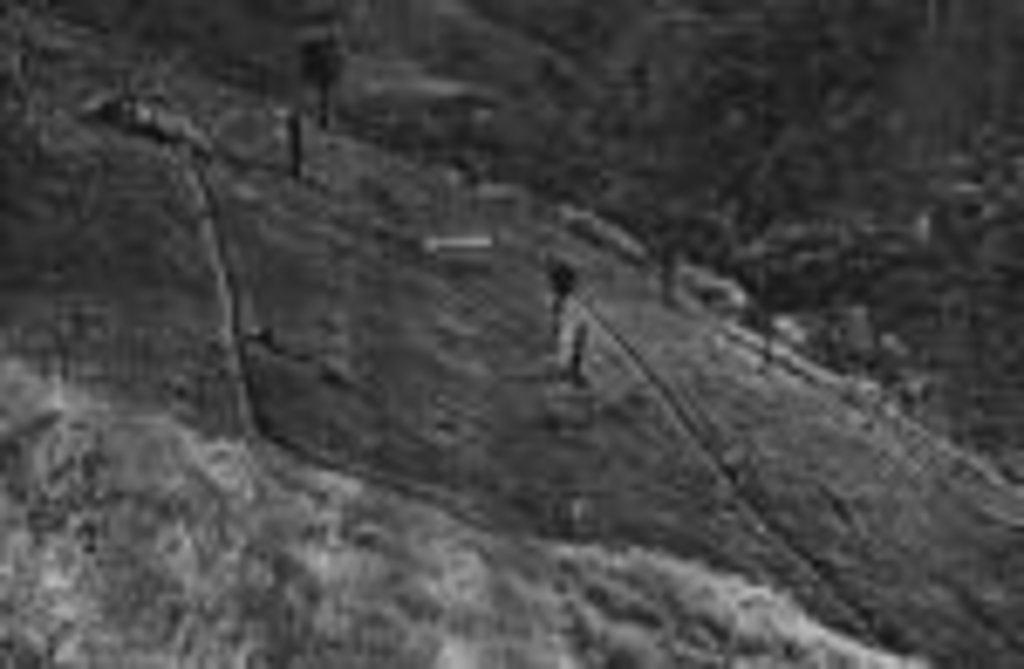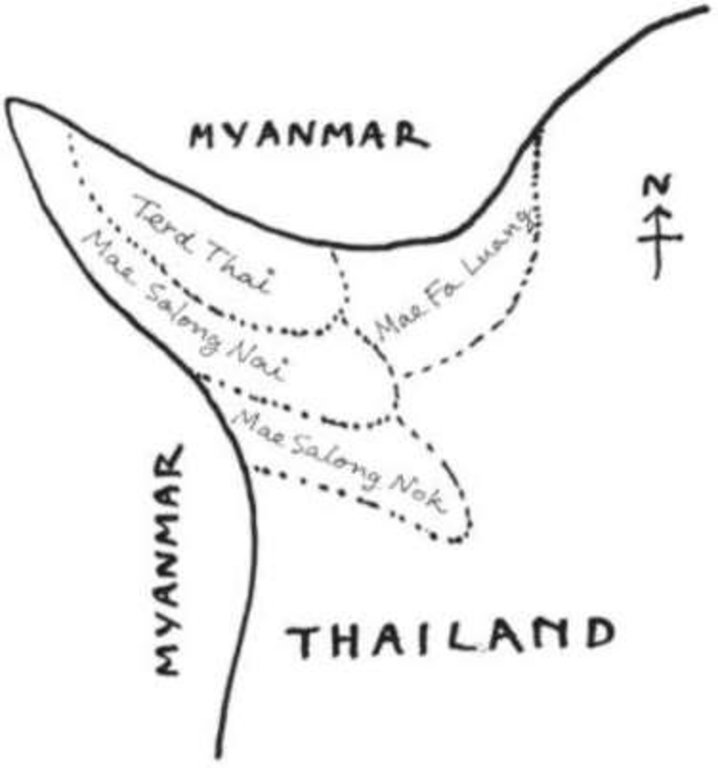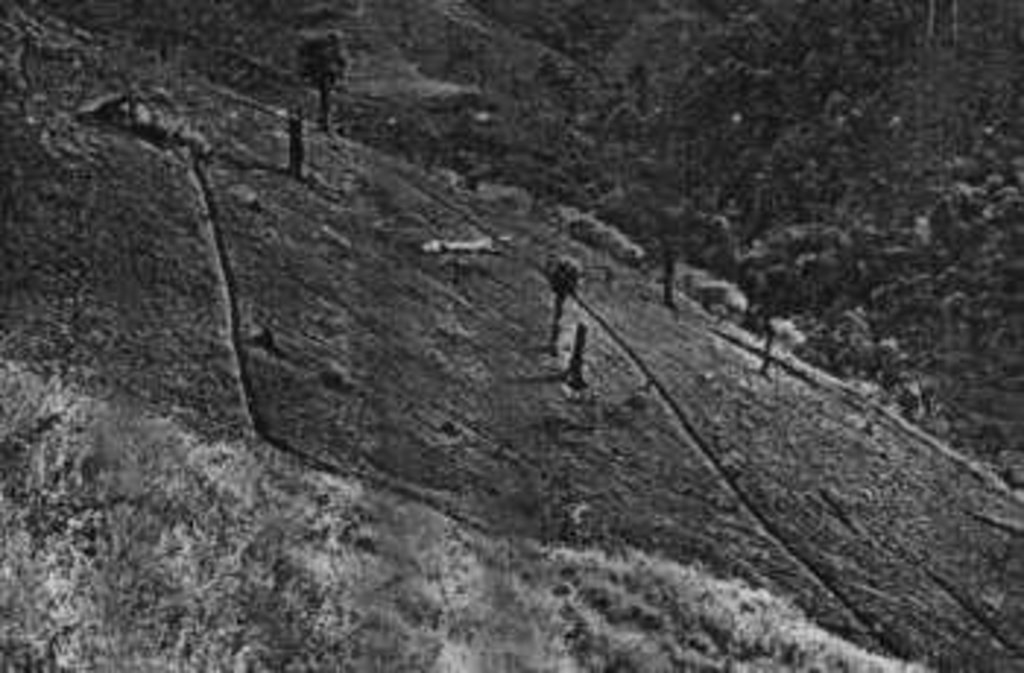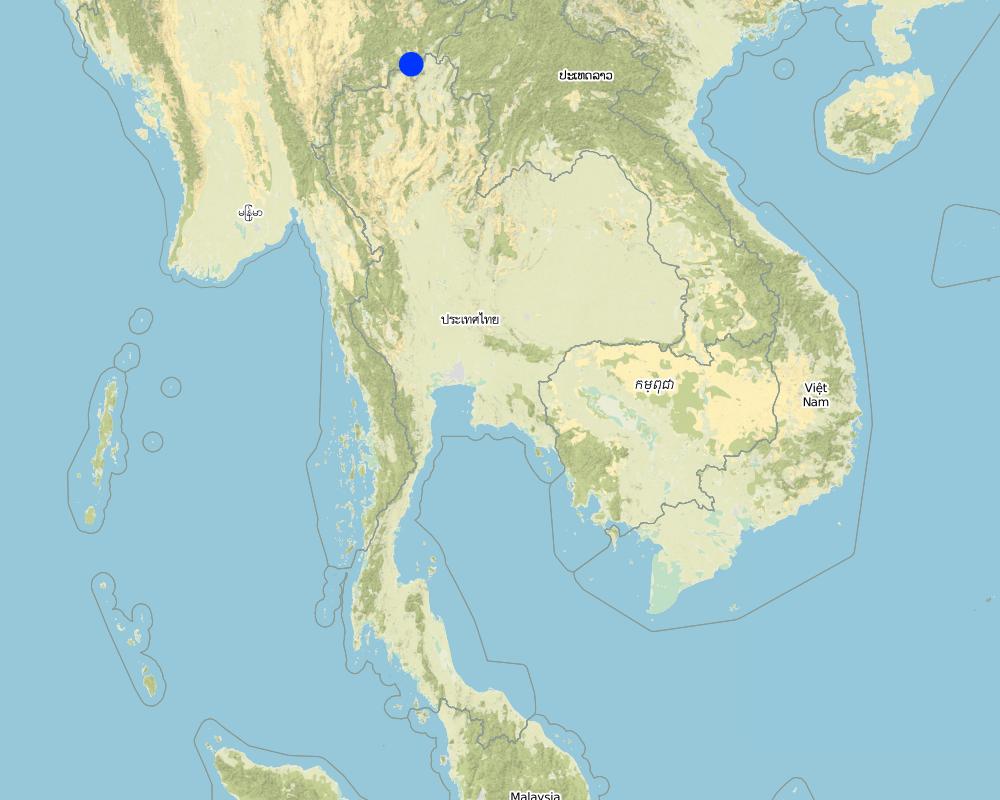Cut-off drain [ไทย]
- ผู้สร้างสรรค์:
- การอัพเดท:
- ผู้รวบรวม: Samran Sombatpanit
- ผู้เรียบเรียง: –
- ผู้ตรวจสอบ: Fabian Ottiger
approaches_2622 - ไทย
ดูส่วนย่อย
ขยายทั้งหมด ย่อทั้งหมด1. ข้อมูลทั่วไป
1.2 รายละเอียดที่ติดต่อได้ของผู้รวบรวมและองค์กรที่เกี่ยวข้องในการประเมินและการจัดเตรียมทำเอกสารของแนวทาง
ผู้เชี่ยวชาญ SLM:
ชื่อของโครงการซึ่งอำนวยความสะดวกในการทำเอกสารหรือการประเมินแนวทาง (ถ้าเกี่ยวข้อง)
World Association of Soil and Water Conservation (WASWC) - จีนชื่อของโครงการซึ่งอำนวยความสะดวกในการทำเอกสารหรือการประเมินแนวทาง (ถ้าเกี่ยวข้อง)
Swiss Agency for Development and Cooperation (DEZA / COSUDE / DDC / SDC) - สวิตเซอร์แลนด์1.3 เงื่อนไขที่เกี่ยวข้องกับการใช้ข้อมูลที่ได้บันทึกไว้ผ่านทาง WOCAT
ผู้รวบรวมและวิทยากรหลักยอมรับเงื่อนไขเกี่ยวกับการใช้ข้อมูลที่ถูกบันทึกผ่านทาง WOCAT:
ใช่
1.4 การอ้างอิงถึงแบบสอบถามเรื่องเทคโนโลยี SLM
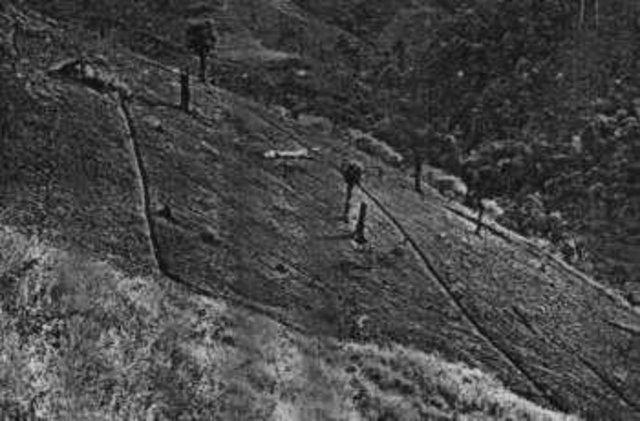
Cut-off drain [ไทย]
Cut-off drain is a drainage ditch dug to quickly drain water out of sloping agricultural land.
- ผู้รวบรวม: Unknown User
2. คำอธิบายของแนวทาง SLM
2.1 การอธิบายแบบสั้น ๆ ของแนวทาง
This approach is the 'way' or 'how' the cut-off drain has been implemented on steepland in northern Thailand.
2.2 การอธิบายอย่างละเอียดของแนวทาง
การอธิบายอย่างละเอียดของแนวทาง:
Aims / objectives: The cut-off drain is a kind of soil conservation measure which functions in the way that excess runoff will gather in these drains, which are constructed parallel with each other, and leave the cropped field without causing damage to it. This cut-off drain will be constructed only on steepland with large acreage. Fields smaller than 0.16 ha will not have it. The digging of the cut-off drain will be done before rainy season, using one hand hoe breadth and 20-30 cm deep. In the following year, loose earth material may be dug up and the drain may eventually be as large as 40 cm wide and 40 cm deep. This is an indigenous practice which farmers do it by themselves in their farm and they are not paid for their wages by any agency. In some cases poorer people may be hired by richer ones to dig cut-off drains. State agencies and extension workers have never promoted this T and A anywhere.
2.3 รูปภาพของแนวทาง
2.5 ประเทศ ภูมิภาค หรือสถานที่ตั้งที่ได้นำแนวทางไปใช้
ประเทศ:
ไทย
ภูมิภาค/รัฐ/จังหวัด: :
Amphur Mae Fa Luang
Map
×2.7 ประเภทของแนวทาง
- แบบดั้งเดิม/ แบบพื้นเมิอง
2.8 เป้าหมายหรือวัตถุประสงค์หลักของแนวทาง
The Approach focused on SLM only
1. To drain runoff water, 2. To reduce soil erosion, 3. To stabilize crop yield.
The SLM Approach addressed the following problems: Steepland in the North, where rainfall is high, has been brought to cultivation. There apparently was a sign of excessive runoff from the land, farmers in the past therefore started to dig the ditch to drain water away to the side of the field.
2.9 เงื่อนไขที่เอื้ออำนวยหรือเป็นอุปสรรคต่อการนำเทคโนโลยีภายใต้แนวทางนี้ไปปฏิบัติใช้
ความรู้เกี่ยวกับ SLM การเข้าถึงการสนับสนุนด้านเทคนิค
- เป็นอุปสรรค
The cut-off drain will not be implemented in small fields, e.g. a field < 0.16 ha.
Treatment through the SLM Approach:
3. การมีส่วนร่วมและบทบาทของผู้มีส่วนได้ส่วนเสียที่เกี่ยวข้อง
3.1 ผู้มีส่วนได้ส่วนเสียที่เกี่ยวข้องในแนวทางนี้และบทบาท
- ผู้ใช้ที่ดินระดับท้องถิ่นหรือชุมชนระดับท้องถิ่น
Specific ethnic groups: E-kaw, Lahu, Lisu, Mien, Khin, Thai Yai, Haw Chinese, H'mong
Farmers do it by themselves. Farmers feel it is necessary to construct the cut-off drain so they will do it inspite of being resource poor if conditions for doing it apply.
3.2 การเกี่ยวข้องของผู้ใช้ที่ดินระดับท้องถิ่นหรือชุมชนระดับท้องถิ่นในช่วงต่างๆของแนวทาง
| ความเกี่ยวข้องของผู้ใช้ที่ดินระดับท้องถิ่นหรือชุมชนระดับท้องถิ่น | ระบุผู้ที่มีส่วนเกี่ยวข้องและอธิบายกิจกรรม | |
|---|---|---|
| การริเริ่มหรือการจูงใจ | ไม่มี | |
| การวางแผน | ไม่มี | |
| การดำเนินการ | ไม่มี | responsibility for major steps |
| การติดตามตรวจสอบหรือการประเมินผล | ไม่มี | |
| Research | ไม่มี |
3.4 การตัดสินใจเลือกใช้เทคโนโลยี SLM
ระบุผู้ที่ทำการตัดสินใจเลือกเทคโนโลยีมากกว่าหนึ่งวิธีไปปฏิบัติใช้:
- ผู้ใช้ที่ดินเพียงผู้เดียว ( ริเริ่มด้วยตัวเอง)
การอธิบาย:
land user driven (bottom-up).
Decisions on the method of implementing the SLM Technology were made by by land users* alone (self-initiative / bottom-up). land user driven (bottom-up).
4. การสนับสนุนด้านเทคนิค การสร้างขีดความสามารถ และการจัดการด้านความรู้
4.2 การบริการให้คำแนะนำ
ผู้ใช้ที่ดินมีการเข้าถึงการรับบริการให้คำปรึกษาหรือไม่:
ใช่
ระบุว่ามีบริการให้คำปรึกษาหรือไม่:
- ไปเยี่ยมชมสถานที่
การอธิบาย/แสดงความคิดเห็น:
Name of method used for advisory service: Farmer to farmer; Key elements: Simplicity, Low cost, Functionality
4.3 การเสริมความแข็งแกร่งให้กับสถาบัน (การพัฒนาองค์กร)
สถาบันได้รับการจัดตั้งขึ้นมาหรือเสริมความแข็งแกร่งโดยแนวทางนี้หรือไม่:
- ไม่
4.5 การวิจัย
การวิจัยเป็นส่วนหนึ่งของแนวทางหรือไม่:
ใช่
- socio-economics, bio-physical
5. การสนับสนุนด้านการเงินและวัสดุอุปกรณ์
5.1 ระบุงบประมาณประจำปีสำหรับแนวทาง SLM นี้
แสดงความคิดเห็น (แหล่งของการระดมทุน ผู้บริจาคคนสำคัญ):
Approach costs were met by the following donors: other (Personal fund): 100.0%
5.2 การสนับสนุนด้านการเงิน / วัสดุอุปกรณ์ให้แก่ผู้ใช้ที่ดิน
ผู้ใช้ที่ดินได้รับการสนับสนุนด้านการเงิน / วัสดุอุปกรณ์ไปปฏิบัติใช้เทคโนโลยีหรือไม่:
ไม่ใช่
5.3 เงินสนับสนุนสำหรับปัจจัยนำเข้า (รวมถึงแรงงาน)
ถ้าแรงงานโดยผู้ใช้ที่ดินเป็นปัจจัยนำเข้าที่มีอยู่มากมาย ระบุด้วยว่าเนื่องจาก:
- สมัครใจ
ความคิดเห็น:
They do it by themselves through their perception.
5.4 เครดิต
มีการจัดหาเครดิตมาให้ภายใต้แนวทาง SLM หรือไม่:
ไม่ใช่
6. การวิเคราะห์ผลกระทบและการสรุป
6.1 ผลกระทบของแนวทาง
ช่วยให้ผู้ใช้ที่ดินนำเอาเทคโนโลยี SLMไปใช้และบำรุงรักษาสภาพไว้ได้หรือไม่:
- ไม่ใช่
- ใช่ เล็กน้อย
- ใช่ ปานกลาง
- ใช่ อย่างมาก
Construction of cut-off drains
Did other land users / projects adopt the Approach?
- ไม่ใช่
- ใช่ เล็กน้อย
- ใช่ ปานกลาง
- ใช่ อย่างมาก
This is considered a way of farming only and may not be regarded as important.
6.3 ความยั่งยืนของกิจกรรมของแนวทาง
ผู้ใช้ที่ดินสามารถทำให้สิ่งต่างๆ ที่ได้ปฏิบัติใช้โดยแนวทางนี้ยั่งยืนได้หรือไม่ (โดยไม่มีการสนับสนุนจากภายนอก):
- ใช่
6.4 จุดแข็งและข้อได้เปรียบของแนวทาง
| จุดแข็ง / ข้อได้เปรียบของแนวทางในทัศนคติของผู้ใช้ที่ดิน |
|---|
| Reduce soil loss in large areas grown to field crop |
| Can use as a path in the field |
| จุดแข็ง / ข้อได้เปรียบของแนวทางในทัศนคติของผู้รวบรวมหรือวิทยากรหลัก |
|---|
| Reduce soil loss in large areas grown to field crop (How to sustain/ enhance this strength: Adjust the gradient not to be too steep so the effect from scouring can be decreased) |
| Can use as a path in the field |
| Reduce soil loss in large areas grown to field crop (How to sustain/ enhance this strength: Adjust the gradient to be less steep, to prevent excessive scouring) |
| Can use as a path in the field |
6.5 จุดอ่อน / ข้อเสียเปรียบของแนวทางและวิธีในการแก้ไข
| จุดอ่อน / ข้อเสียเปรียบในทัศนคติของผู้ใช้ที่ดิน | สามารถแก้ไขปัญหาได้อย่างไร |
|---|---|
| None |
| จุดอ่อน / ข้อเสียเปรียบในทัศนคติของผู้รวบรวมหรือวิทยากรหลัก | สามารถแก้ไขปัญหาได้อย่างไร |
|---|---|
| A part of cropped area is lost. | No way |
7. การอ้างอิงและการเชื่อมต่อ
7.1 วิธีการหรือแหล่งข้อมูล
- ไปเยี่ยมชมภาคสนาม การสำรวจพื้นที่ภาคสนาม
- การสัมภาษณ์กับผู้ใช้ที่ดิน
7.2 การอ้างอิงถึงสิ่งตีพิมพ์
ชื่อเรื่อง ผู้เขียน ปี ISBN:
Turkelboom, f. 1999. On-farm diagnosis of steepland erosion in Northern Thailand. PhD thesis. 309 pp.Pongsapich, A. 1998. Indigenous Technical Knowledge for Land Mgmt in Asia. Issues in sustainable land mgmt No. 3. 152 pp.
ช่องทางในการสืบค้น และราคา:
Katholieke Universiteit Leuven, Leuven, BelgiumIBSRAM, Bangkok
ชื่อเรื่อง ผู้เขียน ปี ISBN:
Pongsapich, A. 1998. Indigenous Technical Knowledge for Land Mgmt in Asia. Issues in sustainable land mgmt No. 3. 152 pp.
ช่องทางในการสืบค้น และราคา:
IBSRAM, Bangkok
ลิงก์และโมดูล
ขยายทั้งหมด ย่อทั้งหมดลิงก์

Cut-off drain [ไทย]
Cut-off drain is a drainage ditch dug to quickly drain water out of sloping agricultural land.
- ผู้รวบรวม: Unknown User
โมดูล
ไม่มีโมดูล



